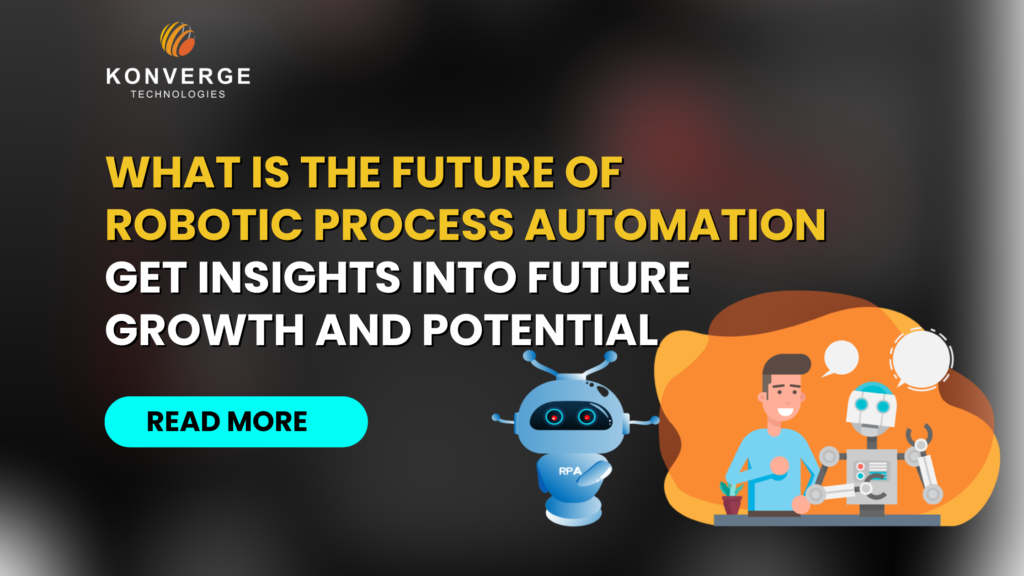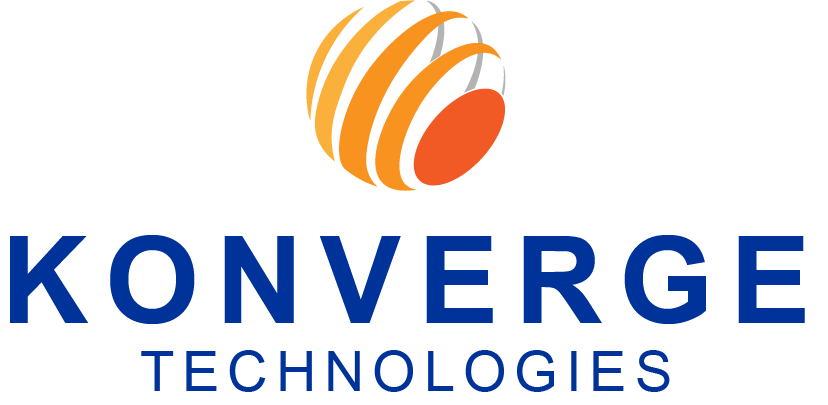
What is the future of robotic process automation get Insights into Future Growth and Potential

Introduction:
Robotic Process Automation (RPA) has marked its significance in the digital transformation era, automating tasks that are repetitive and rule-based, previously performed by humans. At Konverge Technology, we recognize the potential of this technology, especially as the RPA market soared to $2.2 billion in revenue in 2021, and is on a trajectory to reach $5.07 billion by 2026 due to continuous advancements in artificial intelligence (AI) and machine learning (ML). The integration of AI with RPA, often referred to as AI-powered RPA bots, has enhanced the capability of RPA platforms, enabling them to learn from data and manage more complex tasks than traditional bots, thus broadening the future of RPA.
As we delve into the exploration of RPA’s future, it’s evident that its application will be more profound and diversified across industries. This is further supported by the forecast that the global RPA market, catering to the need for efficiency in repetitive tasks traditionally done by humans, is anticipated to grow at a substantial Compound Annual Growth Rate (CAGR) of 24.31%, reaching an impressive $13,871.72 million by 2028. Driving factors such as increased speed and accuracy, cost reductions, and improved quality, followed by the scalability of RPA solutions, signify the immense future potential of RPA technology, as it continues to be a crucial component of digital transformation strategies within numerous sectors.
The Evolution of RPA
At Konverge Technology, we’ve witnessed the remarkable journey of RPA from its nascent stages to becoming a cornerstone in digital transformation. The evolution of RPA is a testament to technological advancement and strategic adaptation across industries.
- Origins and Adoption:
- 1990s: The story of RPA began with automating UI testing, evolving with the advent of Windows 95, which marked a shift in computer user personas.
- Early 2000s: Banks and insurance companies, with their need to manage vast data, were pioneers in adopting automation technologies.
- 2012 Onwards: Recognized by large-scale businesses, RPA became integral for reducing expenses and facilitating digital transformation.
- Democratization and Growth:
- 2020s: Marked by the democratization of RPA, the RPA-as-a-service models made this technology accessible to smaller businesses, significantly contributing to the projected market growth to surpass $12B by 2028 at a 32.8% CAGR.
- Technological Advancements:
- Integration with AI and ML: Elevating RPA from simple task automation to becoming a decision-making tool with capabilities like Intelligent Process Automation (IPA) and Process Mining.
- From Platforms to Solutions: The transition from standalone RPA platforms to comprehensive solutions incorporating BPM, IDP, and unattended automation showcases the future trajectory of RPA, promising more sophisticated applications across various sectors.
This evolution underscores the adaptability and potential of RPA, setting the stage for future innovations and broader applications that Konverge Technology is excited to be a part of.
Emerging Trends in RPA
At Konverge Technology, we’re closely monitoring the evolving landscape of RPA, and several emerging trends are shaping the future of this transformative technology. Here’s a glimpse into what we anticipate:
- Service-Based Automation & Hyper-Automation
- Automation-as-a-Service (AaaS): Continues to drive market growth, making RPA accessible to a broader audience.
- Managed RPA Services: With a focus on cost-effectiveness, these services are becoming a go-to for organizations looking to implement RPA without significant upfront investments.
- Hyper-Automation: Integrating RPA with AI and ML, this approach aims to automate more complex, cognitive tasks, enhancing efficiency across operations.
- Technological Integrations and Advancements
- AI and ML Integration: RPA’s fusion with AI and ML is enabling cognitive automation, allowing bots to handle more sophisticated tasks and decision-making processes.
- Natural Language Processing (NLP) and Computer Vision: These technologies are augmenting RPA capabilities, enabling bots to process unstructured data and visual information more effectively.
- Industry and Function-Specific Applications
- Wider Industry Penetration: From manufacturing to creative industries, RPA’s applications are expanding, offering tailored solutions to meet unique sector needs.
- RPA for Cybersecurity: Leveraging RPA to enhance network monitoring and threat detection showcases the technology’s versatility beyond traditional business processes.
These trends highlight RPA’s trajectory towards more intelligent, accessible, and comprehensive automation solutions, underlining our commitment at Konverge Technology to stay at the forefront of digital transformation.
RPA’s Impact Across Industries
RPA’s transformative impact is evident across a diverse range of industries, each leveraging automation to enhance efficiency, reduce costs, and improve service quality. Here’s how RPA is revolutionizing operations in key sectors:
- Finance and Banking: Automating data entry, account reconciliation, and fraud detection to expedite processes and minimize errors.
- Healthcare: Streamlining claims processing, appointment scheduling, and medical record management, significantly reducing paperwork.
- Insurance: Enhancing underwriting, claims processing, and policy administration for faster, more accurate service delivery.
- Manufacturing: Optimizing supply chain management, inventory control, and quality assurance for higher product quality and cost savings.
- Human Resources: Increasing efficiency and accuracy in recruitment, onboarding, payroll processing, and employee data management.
Furthermore, RPA’s role in enhancing cybersecurity protocols, managing inventory, and detecting issues in real-time showcases its broad applicability. With the potential for up to 60% cost savings and substantial improvements in market performance, RPA stands as a cornerstone technology across industries, driving innovation and efficiency.
Challenges and Considerations for Future RPA Deployment
As we navigate the future of RPA, several challenges and considerations emerge, crucial for organizations aiming to leverage this technology effectively:
- Integration and Scalability:
- Compatibility Issues: Integrating RPA with existing systems may present hurdles, particularly when blending different technologies and protocols.
- Scalability Concerns: Organizations must design RPA systems with growth in mind, ensuring they can handle increasing data flow and workload volumes without compromising performance.
- Infrastructure and Maintenance:
- IT Infrastructure: A robust IT infrastructure is vital, requiring adequate processing power, storage capacity, and security measures to protect sensitive data.
- Ongoing Maintenance: Regular monitoring and updating of RPA systems are essential to address errors and optimize performance. This includes stress testing, data management, and designating an RPA system owner for accountability.
- Strategic and Regulatory Challenges:
- Change Management: Successfully integrating RPA requires a comprehensive approach, including technological readiness, employee engagement, and process optimization.
- Regulatory Compliance: Meeting stringent compliance requirements, especially in regulated industries like finance and healthcare, necessitates built-in monitoring, logging, and encryption capabilities within RPA platforms.
Addressing these challenges requires a strategic approach, ensuring RPA deployment aligns with organizational goals and industry standards, thereby maximizing the technology’s benefits while mitigating potential risks.
Case Studies of Successful RPA Implementation
In exploring the transformative power of Robotic Process Automation (RPA), we at Konverge Technology have observed remarkable success stories across various industries. These case studies exemplify the efficiency, cost reduction, and scalability achieved through strategic RPA implementation:
- Manufacturing and Banking Efficiency:
- A leading manufacturer leveraged Nividous Smart Bots for automating invoice processing, significantly enhancing invoice approval times and managing a growing volume of invoices.
- A fast-growing bank experienced a 78% reduction in turnaround time for loan processing and a 20% increase in business by automating its business loan process.
- Healthcare and Insurance Process Optimization:
- A specialty healthcare management company reduced the handling time of the claim submission process by 70% through automated data extraction, review, and submission tasks.
- An insurance company simplified complex, Excel-based premium calculations using RPA bots, creating custom quotes within seconds, showcasing the versatility of RPA in handling intricate data processes.
- Innovative Applications in Diverse Fields:
- Deloitte, a leader in the consulting industry, significantly reduced report preparation time through the use of RPA, demonstrating the potential of RPA in professional services.
- In the logistics sector, Inter Aduaneira freed up thousands of manual work hours by automating shipment tracking, illustrating how RPA can revolutionize operational efficiency.
These examples underscore the broad applicability and benefits of RPA across different sectors, highlighting the potential for future growth and innovation. Through strategic deployment, companies have realized significant efficiency improvements, cost reductions, and enhancements in service quality, affirming the role of RPA as a pivotal technology in the digital transformation journey.
Throughout this exploration, we’ve delved into the transformative potential that Robotic Process Automation (RPA) presents as a linchpin in the digital transformation era. The integration of AI and ML with RPA, broadening its application across diverse industries, coupled with the trends that advocate for a future rich in innovation and efficiency, underscore the critical role RPA is poised to play. The remarkable growth projection, backed by case studies of successful implementation, not only reaffirms the significant impact of RPA on operational efficiency and cost reduction but also sets a promising trajectory for its evolution.
As we stand on the cusp of this technological evolution, it is imperative to navigate the challenges associated with RPA deployment strategically, ensuring alignment with organizational goals and industry standards. The journey ahead for RPA is one of vast potential and requires concerted efforts in addressing integration, scalability, and regulatory considerations. The continued investment in RPA, underpinned by a deep understanding of its implications and significance, will undoubtedly drive future growth and innovation across sectors, solidifying RPA’s position as a cornerstone of digital transformation strategies.



